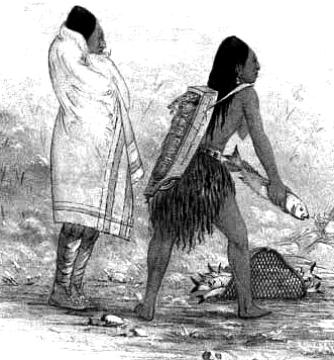
The Cowlitz Native Americans.
Cowlitz people are a southwestern Coast Salish indigenous peoples of the Pacific Northwest. Today they are enrolled in the federally recognized tribes: Cowlitz Indian Tribe, Quinault Indian Nation and the Confederated Tribes of the Chehalis Reservation.
Their traditional homelands are in western Washington state in the United States. The Cowlitz tribe consists of two distinct groups: the Upper Cowlitz, or Taidnapam, and the Lower Cowlitz, or Kwalhiokwa.
The original language of Cowlitz tribes, the Cowlitz language, belonged to the Salishan family of languages among Northwest Coast indigenous peoples. Later, the Upper Cowlitz adopted the Sahaptin language from east of the Cascade Mountains. Modeste Demers reported that the Cowlitz peoples were fluent in Chinook Jargon.
The Cowlitz Indian Tribe were federally recognized on February 14, 2000, and their acknowledgement was reaffirmed in 2002. They are now recognized officially by the United States federal government, and are in the process of establishing federally recognized tribal lands (such as on a reservation) near Longview, Washington. The tribal offices are in Longview, Washington.
The Cowlitz political system evolved:
"from a strong system of chiefs, to an elective presidential system in the early 20th century; and a constitutional elective Tribal Council system after 1950. Chief How-How (c. 1815), Chief Kiscox (c. 1850), Chief Umtux (c. 1850), Chief Scanewa (c. 1855), Chief Richard Scanewa (c. 1860) and Chief Antoine Stockum [Atwin Stokum] (1878) led the Cowlitz in the 19th century. Twentieth century figures include Chief Baptiste Kiona (1912), President Dan Plamondon (1921), President John Ike Kinswa (1922), Chairman John B. Sareault (c. 1925), Chairman Jas. E. Sareault (c. 1930), Chairman Manual L. Forrest (1950), Chairman Joseph Cloquet (1959), Chairman Clifford Wilson (1961) and Chairman Roy Wilson (1974).
The Cowlitz produced fully imbricated, coiled baskets with strong geometric designs. These were made of bear grass, cedar root, horse tail root and cedar bark and were used to gather berries and fruits. Such baskets were often repaired and kept through many generations.
The Cowlitz tribe was historically based along the Cowlitz and Lewis Rivers, as well as having a strong presence at Fort Vancouver. The first white known to have contacted the Cowlitz was French-Canadian Simon Plamondon of Quebec. He eventually married Chief Scanewea's daughter, Thas-e-muth. Several other French-Canadians settled near by Plamondon and also took up farming. Catholic missionaries began to visit the Cowlitz people in late 1838, with the St. Francis Xavier Mission eventually being built there. In December of that year, François N. Blanchet preached from Plamondon's residence to the farmers and several Cowlitz natives. After the priest left, the Cowlitzes reportly told the French-Canadian farmers that "We want to do something for them, we will work, make fences, and whatever they wish us to do." The Hudson's Bay Company agricultural subsidiary Puget Sound Agricultural Company established Fort Cowlitz in 1839.*
CHUEN
Kin 251: Blue Self-Existing Monkey
I define in order to play
Measuring illusion
I seal the process of magic
With the self-existing tone of form
I am guided by the power of accomplishment.
The time-space that we live in and the types of questions we ask about that time-space affect the quality of the answers we receive.*
*Star Traveler's 13 Moon Almanac of Synchronicity, Galactic Research Institute, Law of Time Press, Ashland. Oregon, 2016-2017.
The Sacred Tzolk'in
Visshudha Chakra (Alpha Plasma)





No comments:
Post a Comment